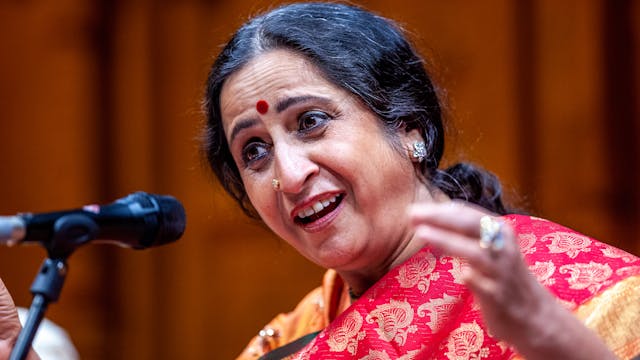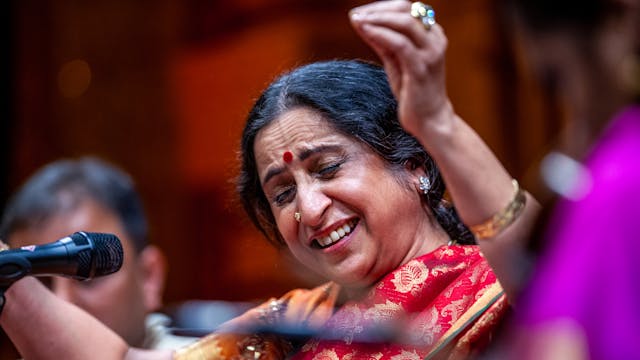Malladi Brothers | Kambhoji
Carnatic Tradition
•
19m
Recorded at Darbar Festival 2018, on 26th April, at Milton Court Concert Hall, the Barbican, London.
Musicians:
- Sreeramprasad Malladi (vocal)
- Ravikumar Malladi (vocal)
- Lalgudi Vijayalakshmi (violin)
- Trichy Sankaran (mridangam)
- Giridhar Udupa (ghatam)
- Priya Sharma & Srutti Suresan (tanpuras)
Raag Kambhoji, Sanskrit composition by Muthuswamy Dikshitar (1775-1835)
‘Kailasa Nathena’, is a Sanskrit devotional kriti (composition) in Raag Kambhoji composed by Muthuswamy Dikshitar (1775 – 1835). It is set to Raag Kambhoji which can portray rasas (emotions) like vira (valour) and sṛingara (romantic) very effectively.
With a sharp sense of coordination, the Malladi brothers perform this composition with enticing niravals (improvisation with lyrics) and swarakalpanas (improvisation using notes). While one swoops to the lower octave, the other immediately soars powerfully to the higher notes, bringing beautiful shades to the canvas. They introduce the raga with a detailed alapana, highlighting the colours of Kambhoji.
After finishing their bit, they provide ample opportunity to Vijayalakshmi to introduce the raga further with her dulcet and graceful phrases. She further explores Kambhoji with elegant glides and poignant, curly notes, paving the way further for them to embark on the kriti again. The brothers take the lead weaving short, simple but exquisite patterns, eventually involving the whole ensemble to replicate and improvise upon.
Trichy Sankaran (mridangam) and Giridhar Udupa (ghatam) give a masterful support to the whole performance.
Kambhoji is a bhaṣanga janya of the 28th meḷakarta Harikambhoji. It is a ṣaḍava-vakra sampurṇa raga. The swaras present in this raga in ascent are ṣaḍja, chatusruti riṣabha, antara gandhara, suddha madhyama, pachama, chatusruti dhaivata. Kaisiki niṣada occurs in descent. Kakali niṣada, which is an additional note that is not present in its parent raga Harikambhoji, is seen in the phrase S N3 P D2 S. Kambhoji is a raga which has existed since olden times. It finds mention in treatises as far back in history as 7th century CE. It is equivalent to the paṇṇ Ṭakkesi. Kambhoji does not have an exact equivalent in Hindustani music, but its parent raga Harikambhoji finds an equivalent in the Khamaj that. It is a rakti raga or a raga which pleases instantaneously. It is a major raga that offers ample scope for improvisation. There are a number of compositions covering almost all varieties of compositional forms. Madhyama, dhaivata, niṣada are ragachaya swaras. Gandhara, madhyama, pancama and dhaivata are nyasa swaras. Sa-ma, sa-pa, ri-da, ri-pa, ga-da are vadi-samvadi swaras (consonant notes).
Up Next in Carnatic Tradition
-
Jyotsna Srikanth | Mohanam
Recorded at Darbar Festival 2007, on 15th April, at the Phoenix Theatre Leicester.
Musicians:
- Jyotsna Srikanth (violin)
- Neyveli Venkatesh (mridangam)
- RN Prakash (ghatam and khanjira)Varnam in Raag Mohanam in Adi talam
This is the opening piece of Dr. Jyotsna Srikanth’s concert at the Da...
-
Aruna Sairam | Mohanam
Recorded at Darbar Festival 2009, on 3rd April, at the Purcell Room of London's Southbank Centre.
Musicians:
- Aruna Sairam (Carnatic Vocal)
- Patri Satish Kumar (Mridangam)
- Jyotsna Srikanth (Violin)
- RN Prakash (Ghatam)
- Priya Prakash (Tanpura)Kriti in Raga Mohanam in Adi talam
Raga ...
-
Aruna Sairam | Kalinga Nartana Tillana
Recorded at Darbar Festival 2009, on 3rd April, at the Purcell Room, at the Queen Elizabeth Hall, at London's Southbank Centre.
Musicians:
- Aruna Sairam (vocals)
- Jyotsna Srikanth (violin)
- Patri Satish Kumar (mridangam)
- RN Prakash (ghatam)
- Priya Parkash (tanpura)Thillana in R...



